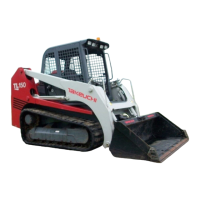V-2
TROUBLESHOOTING
CAUTIONS IN TROUBLESHOOTING AND REPAIRS
(1) Do not begin disassembling the equipment immediately just because it has broken down.
Conduct a thorough preliminary check before attempting disassembly.
a. Ask the user the following questions.
• What were the conditions when the machine broke down?
• Did anything abnormal happen before breakdown occurred?
• Are there any other places which were functioning poorly other than the part that
broke down?
• Are there any parts which have been repaired previous to the breakdown? What were
they?
• Has the same thing happened before?
b. Run the machine yourself and confirm the breakdown conditions.
• Judge whether the machine is really broken down or not following the judgment stan
-
dards.
The judgment on whether the machine has broken down may differ between individu
-
als.
IMPORTANT: When running the machine, it is possible that moving the machine could
make the breakdown worse than it already is, so do not forget to ask the user if there
is anything to prevent your operating the machine.
c. Based on the information that you have gathered from the user and the information
obtained from running the machine yourself, judge the cause of the trouble. Also keep
in mind that it is difficult to reproduce the conditions of the breakdown again once
the machine has been disassembled, and early disassembly may make it impossible to
determine the true cause of the trouble. Therefore be sure to find the true cause of the
trouble before attempting disassembly.
(2) When it is thought that the trouble has more than one cause, begin investigating from the
simplest cause.
(3) Think over why the trouble could have occurred and try to correct the root cause of that
problem.

